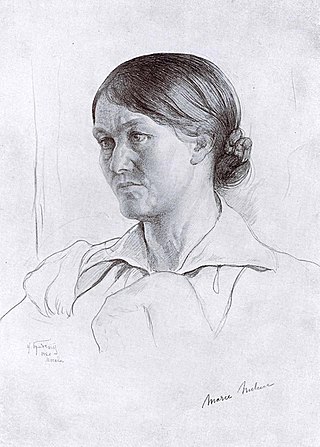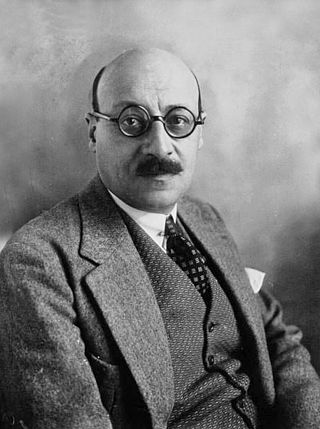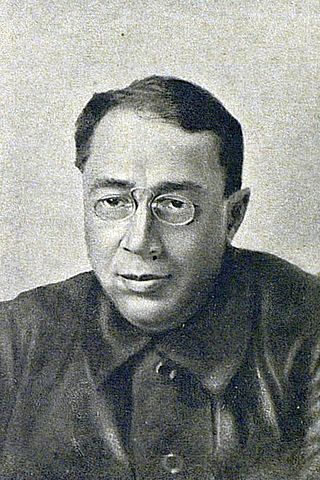Related Research Articles

The Communist International (Comintern), also known as the Third International, was an international organization founded in 1919 that advocated world communism, and which was led and controlled by the Communist Party of the Soviet Union. The Comintern resolved at its Second Congress in 1920 to "struggle by all available means, including armed force, for the overthrow of the international bourgeoisie and the creation of an international soviet republic as a transition stage to the complete abolition of the state". The Comintern was preceded by the dissolution of the Second International in 1916. Vladimir Lenin and Leon Trotsky were both honorary presidents of the Communist International.

Vasil Petrov Kolarov was a Bulgarian communist political leader and leading functionary in the Communist International (Comintern).

Marie-Sophie Nielsen was a Danish communist leader who was a founding member of the Danish Socialist Workers Party and the Communist Party of Denmark.

Ludovic-Oscar Frossard, also known as L.-O. Frossard or Oscar Frossard, was a French socialist and communist politician. He was a founding member in 1905 and Secretary-General of the French Socialist Party (SFIO) from 1918 to 1920, as well as a founding member and Secretary-General of the French Communist Party (PCF) from 1920 to 1922.

Jukka Rahja was a Russian-Finnish Bolshevik who was killed by the Petrograd Opposition.

Milorad M. Drachkovitch was a Serbian American political scientist.

László Rudas was a Hungarian communist newspaper editor, philosopher, professor and politician who become director of the Central Party School of the Communist Party of Hungary.
Ghiță Moscu was a Romanian socialist and communist activist, one of the early leaders of the Romanian Communist Party and its permanent delegate to the Third International. He was executed in the Soviet Union during the Great Purge.

Victorio Codovilla, born Vittorio Codovilla, was an Italian-born Argentine socialist and later communist politician. At first a member of the Italian Socialist Party, he emigrated to Argentina in 1912 and went on to hold prominent posts in the Comintern and the Communist Party of Argentina (PCA), of which he was General Secretary in 1941–1963 and President in 1963–1970.

Endre Rudnyánszky was a Hungarian lawyer, military officer, and communist. He held leadership posts in international and Hungarian communist organizations until his disappearance in 1921.
Jaroslav Handlíř was a Czech politician and soldier who was a leader in both Czechoslovak and international communism and later joined the Social Democratic Party of Czechoslovakia.

The 2nd World Congress of the Communist International was a gathering of approximately 220 voting and non-voting representatives of communist and revolutionary socialist political parties from around the world, held in Petrograd and Moscow from July 19 to August 7, 1920. The 2nd Congress is best remembered for formulating and implementing the 21 Conditions for membership in the Communist International.
The 1st Congress of the Communist International was an international gathering of communist, revolutionary socialist, and syndicalist delegates held in Moscow which established the Communist International (Comintern). The gathering, held from March 2 to 6, 1919, was attended by 51 representatives of more than two dozen countries from around Europe, North America, and Asia.
The Young Communist League of Czechoslovakia, nicknamed Komsomol, was a youth organization in Czechoslovakia, active between 1921 and 1936. The organization was the youth wing of the Communist Party of Czechoslovakia. The organization was the Czechoslovak section of the Young Communist International.
Institut Maurice Thorez was a French research institution linked to the French Communist Party. The Institute was set up in the mid-1960s, as part of a process of ideological reorientation of the Communist Party. These two new institutes encouraged more creative forms of applications of Marxism to theoretical and political problems. At the Institut Maurice Thorez communist historians were able to research without strict party control. The Institute published Cahiers de l'Institut Maurice Thorez.

The Executive Committee of the Communist International, commonly known by its acronym, ECCI (Russian acronym ИККИ - for Исполнительный комитет Коммунистического интернационала), was the governing authority of the Comintern between the World Congresses of that body. The ECCI, established by the Founding Congress of the Comintern in 1919, was dissolved with the rest of the Comintern in May 1943.

Masanosuke Watanabe was a member of the Japanese Communist Party. He was born in 1899 in Ichikawa, Chiba Prefecture. He was the son of a tatami mat maker. After graduating primary school in 1912, he went to Tokyo to work in a wine shop. In 1917, he worked in a celluloid factory in Kamedo section of Tokyo. He organized the National Celluloid Workers Union in Tokyo in 1919. He joined the Japanese Communist Party soon after its establishment in 1922. In March 1927, he went to Moscow to represent the JCP at the Comintern, and the eighth enlarged plenum of the ECCI. That same year, Watanabe returned to Japan and took over the leadership of the party. In March 1928, he was elected chairman of the JCP central committee. During Watanabe's lifetime, he married Tanno Setsu, a labour activist, and member of the Communist Party.
Eduard (War) Van Overstraeten was a Flemish communist activist and painter. He was one of the founders of the Communist Party of Belgium.

Sergei Ivanovich Gusev was a Russian revolutionary, a founding member of the Bolshevik faction of the Russian Social Democratic Labour Party (RSDLP), and Soviet politician.

Khristo Stefanov Kabakchiev was a Bulgarian communist politician, revolutionary, journalist and historian.
References
- 1 2 Riddell, John. Founding the Communist International: Proceedings and Documents of the 1. Congress, March 1919. New York: Anchor Foundation, 1987. p. 384
- 1 2 3 4 5 Wohl, Robert. French Communism in the Making, 1914-1924 . Stanford, Calif: Stanford University Press, 1966. p. 143
- ↑ Lazić, Branko M., and Milorad M. Drachkovitch. Biographical Dictionary of the Comintern . Stanford, Calif: Hoover Institution Press, 1986. p. 411
- ↑ DELEGATES TO THE FOUNDING CONGRESS OF THE COMMUNIST INTERNATIONAL
- ↑ Gruber, Helmut, and Pamela M. Graves. Women and Socialism, Socialism and Women: Europe between the Two World Wars . Providence, R.I.: Berghahn Books, 1999. p. 327
- ↑ Lazić, Branko M., and Milorad M. Drachkovitch. Biographical Dictionary of the Comintern . Stanford, Calif: Hoover Institution Press, 1986. p. 141